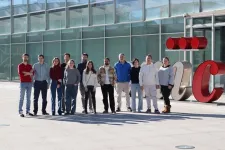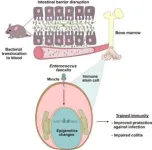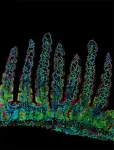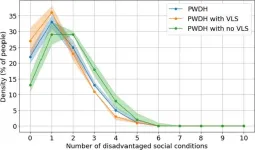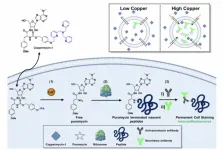(Press-News.org)
A study led by David Sancho at the Centro Nacional de Investigaciones Cardiovasculares (CNIC) in Madrid reveals how an increase in intestinal permeability allows the natural gut bacteria to cross the intestinal barrier and reach the bone marrow, where they induce epigenetic changes—modifications that alter gene activity without affecting DNA sequence—in the stem cells that give rise to immune cells. The epigenetic changes induced by the translocated gut bacteria generate “trained” immune cells primed to respond more efficiently to future infections. However, this same ability to amplify the immune response can also aggravate the inflammatory conditions such as cardiovascular and neurodegenerative diseases. The new study highlights the key role in this process of a protein called Mincle, expressed in cells of the innate immune system.
The study is published in the journal Immunity and was conducted in collaboration with research teams led by José Luis Subiza (Inmunotek S.L., Alcalá de Henares), Carlos del Fresno (IdiPaz, Madrid), Salvador Iborra (Universidad Complutense de Madrid), and Juan Duarte (Universidad de Granada).
Trained immunity, explained David Sancho, who leads the Immunobiology lab at the CNIC, allows macrophages and other cells of the innate immune system to respond more efficiently to future encounters with bacteria, fungi, or viruses. “The protection this mechanism provides against viral and fungal infection has been demonstrated in animals with heightened intestinal permeability, which resulted in a stronger inflammatory response and greater resistance to infection.”
Until very recently, scientists believed that specific—or adaptive—immunity was the only type with memory, able to generate cells that ‘remember’ previous encounters with pathogens and unleash a specific immune response. In contrast, the innate immune response, which is not specific to a particular pathogen, was believed to lack memory. “We now know that innate immunity can be ‘trained’ to produce a stronger response to later, unrelated infections. What is more, the effects of this training are long-lasting,” explained Dr. Sancho.
First author Iñaki Robles added that, “the main intestinal bacteria we find in the bone marrow is Enterococcus faecalis. These bacteria interact with and activate Mincle in hematopoietic precursors, inducing epigenetic changes that generate immune cells with an augmented inflammatory capacity.” [Enterococcus faecalis is a Gram-positive bacterial species that lives in the gastrointestinal tracts of humans and other mammals and can cause difficult-to-treat infections in humans, especially in hospital settings].
A double-edged sword
Although trained immunity can help the fight against infection, it can also contribute to the development of inflammatory diseases. As David Sancho warned, “cardiovascular conditions such as atherosclerosis, and also neurodegenerative diseases, are linked to trained immunity, and these conditions can worsen when this process is exacerbated by elevated intestinal permeability.”
In animal models, increased intestinal permeability causes colonic inflammation (colitis). This inflammatory reaction does not occur in mice engineered to lack Mincle, suggesting that the detection of translocated bacteria by Mincle plays an important role in the inflammation associated with trained immunity. Strategies aimed at blocking Mincle could thus be protective in the context of these systemic inflammatory diseases.
A poor diet (especially a high intake of processed foods), excessive alcohol consumption, chronic stress, and some medicines can all weaken the intestinal barrier and promote bacterial translocation. Maintaining a balanced diet rich in fruit and vegetables helps to maintain a healthy intestine, reduce systemic inflammation, and prevent chronic diseases.
The findings of the study open new routes to understanding the relationship between gut health and systemic diseases, underlining the importance of a healthy diet and a balanced microbiota as key elements in disease prevention.
The study was funded by the Spanish Ministerio de Ciencia, Innovación y Universidades-Agencia Estatal de Investigación (AEI); the European Union NextGenerationEU/PRTR; the Comunidad de Madrid; the Fundación Científica de la Asociación Española Contra el Cáncer; the Worldwide Cancer Research; the European Research Council; Inmunotek S.L., and Fundación “la Caixa
The CNIC is an affiliate center of the Carlos III Health Institute (ISCIII), an executive agency of the Spanish Ministry of Science, Innovation, and Universities. Directed by Dr. Valentín Fuster, the CNIC is dedicated to cardiovascular research and the translation of the knowledge gained into real benefits for patients. The CNIC has been recognized by the Spanish government as a Severo Ochoa center of excellence (award CEX2020-001041-S, funded by MICIN/AEI/10.13039/501100011033). The center is financed through a pioneering public-private partnership between the government (through the ISCIII) and the Pro-CNIC Foundation, which brings together 11 of the most important Spanish private companies.
END
In the world of modern optics, frequency combs are invaluable tools. These devices act as rulers for measuring light, enabling breakthroughs in telecommunications, environmental monitoring, and even astrophysics. But building compact and efficient frequency combs has been a challenge—until now.
Electro-optic frequency combs, introduced in 1993, showed promise in generating optical combs through cascaded phase modulation but progress slowed down because of their high power demands and limited bandwidth. This led to the field being dominated by femtosecond lasers and Kerr soliton microcombs, which, while effective, require complex tuning and ...
Seattle, WASH.—January 22, 2025—The human immune system is like an army of specialized soldiers (immune cells) each with a unique role to play in fighting disease. In a new study published in Nature, led by scientists at the Allen Institute, La Jolla Institute for Immunology, and UC San Diego, researchers reveal how cells known as tissue-resident memory CD8 T cells, play unique and specialized roles based on where they are located within the small intestine. Tissue-resident memory cells provide a local first ...
Thanks to a new technology called Moscot (“Multi-Omics Single-Cell Optimal Transport”), researchers can now observe millions of cells simultaneously as they develop into a new organ—for example, a pancreas. This groundbreaking method was developed by an international research team led by Helmholtz Munich and has been published in the renowned journal Nature.
Until now, biologists had only a limited understanding of how cells develop in their natural environment—for instance, when they form an organ in the ...
January 22, 2025
New Study Finds Social Programs Could Reduce the Spread of HIV by 29%
Although HIV was used as a case study, the UMass Amherst researchers say their assessment tool has applications for other diseases
AMHERST, Mass. — Researchers at the University of Massachusetts Amherst have quantified the impacts of a constellation of social factors on the spread of HIV. Their study, published in Health Care Management Science, found that a hypothetical 100% effective intervention addressing barriers to HIV treatment and care from depression, homelessness, ...
New University of Virginia School of Medicine research revealing the fingerprints of Sudden Infant Death Syndrome within blood samples could open the door to simple tests to identify babies at risk.
The findings also represent an important step forward in unraveling the causes of SIDS, an unexplained condition that is the No. 1 killer of babies between amonth and a year old.
The UVA researchers analyzed blood serum samples collected from infants who died ...
Ozone (O3) exposure may reduce the availability of oxygen in the body, resulting in arterial stiffening due to the body’s natural response to create more red blood cells and hemoglobin, according to a study published today in JACC, the flagship journal of the American College of Cardiology.
“Researchers found that even brief exposure to elevated ozone levels reduced blood oxygen saturation, triggered hypoxia-related biomarkers, and increased arterial stiffness, highlighting the novel connection between ozone exposure and arterial stiffness, demonstrated through comprehensive biomarker analysis in a high-altitude ...
The Chang Lab at Princeton Chemistry continues in its mission to elucidate the role of metal nutrients in human biology: last year, iron; this year, copper. The lab’s first paper of 2025 showcases its development of a revelatory sensing probe for the detection of copper in human cells and then wields it to uncover how copper may be regulating cell growth in lung cancer.
Researchers also offer a possible treatment modality in which copper chelation shows promising results in certain lung cancers where cells have two related phenomena: a heightened transcription factor responding to oxidative stress and a diminished level of bioavailable copper.
Their collaborative paper, A histochemical ...
Despite significant therapeutic advances, breast cancer remains a leading cause of cancer-related death in women. Treatment typically involves surgery and follow-up hormone therapy, but late effects of these treatments include osteoporosis, sexual dysfunction and blood clots. Now, researchers reporting in ACS Central Science have created a novel treatment that eliminated small breast tumors and significantly shrank large tumors in mice in a single dose, without problematic side effects.
Most breast cancers are ...
PULLMAN, Wash. – When it comes to getting people to want to go places, the future is ever more lovely than the past, according to a new Washington State University-led study in the Journal of Hospitality and Tourism Research.
Led by Ruiying Cai, an assistant professor in the Carson College of Business, the study found that forestalgia-focused destination ads—those that emphasize an idealized future—are more effective at enticing travelers to click the purchase button for a vacation than ads based on fond recollections. The research also revealed that forestalgia advertising is particularly effective for getting people to book near-term trips, as imagining ...
COLUMBUS, Ohio – Black immigrants moving into a neighborhood can help shift the overall racial and ethnic character of the area, a new study suggests.
A researcher from The Ohio State University found that when Black immigrants move into a majority native-Black neighborhood, there is an increase in the white population moving in while native Black residents move out.
“Blackness can’t be treated as a monolith within the United States today, where there is a growing Black immigrant population,” said Nima Dahir, author of the study and assistant professor of sociology at Ohio State.
“There is a lot of complexity ...
